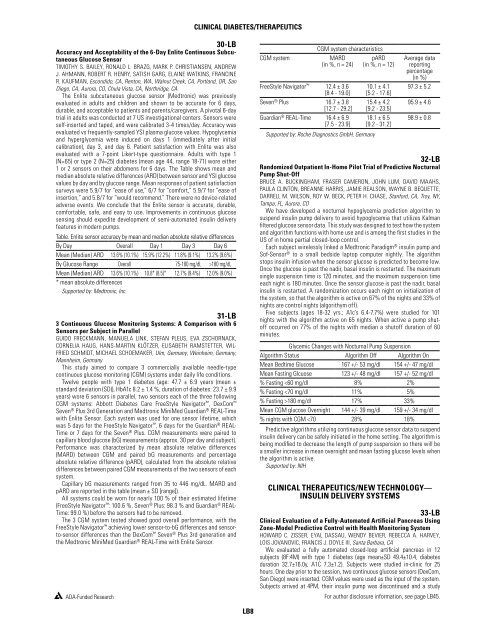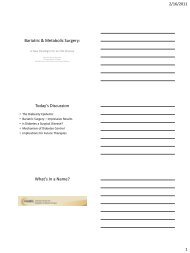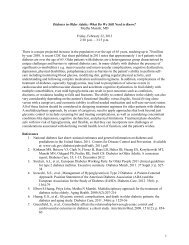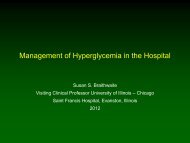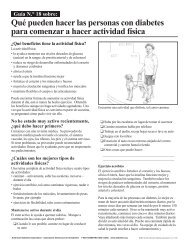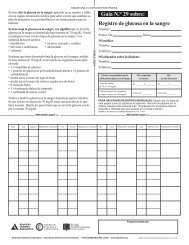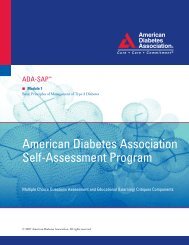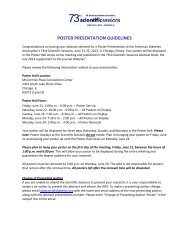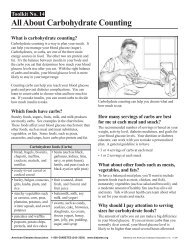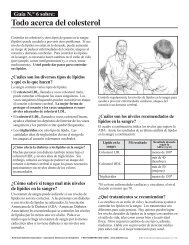A JournAl of the AmericAn DiAbetes AssociAtion
A JournAl of the AmericAn DiAbetes AssociAtion
A JournAl of the AmericAn DiAbetes AssociAtion
- No tags were found...
Create successful ePaper yourself
Turn your PDF publications into a flip-book with our unique Google optimized e-Paper software.
Clinical Diabetes/Therapeutics30-LBAccuracy and Acceptability <strong>of</strong> <strong>the</strong> 6-Day Enlite Continuous SubcutaneousGlucose SensorTIMOTHY S. BAILEY, RONALD L. BRAZG, MARK P. CHRISTIANSEN, ANDREWJ. AHMANN, ROBERT R. HENRY, SATISH GARG, ELAINE WATKINS, FRANCINER. KAUFMAN, Escondido, CA, Renton, WA, Walnut Creek, CA, Portland, OR, SanDiego, CA, Aurora, CO, Chula Vista, CA, Northridge, CAThe Enlite subcutaneous glucose sensor (Medtronic) was previouslyevaluated in adults and children and shown to be accurate for 6 days,durable, and acceptable to patients and parents/caregivers. A pivotal 6-daytrial in adults was conducted at 7 US investigational centers. Sensors wereself-inserted and taped, and were calibrated 3-4 times/day. Accuracy wasevaluated vs frequently-sampled YSI plasma glucose values. Hypoglycemiaand hyperglycemia were induced on days 1 (immediately after initialcalibration), day 3, and day 6. Patient satisfaction with Enlite was alsoevaluated with a 7-point Likert-type questionnaire. Adults with type 1(N=65) or type 2 (N=25) diabetes (mean age 44, range 18-71) wore ei<strong>the</strong>r1 or 2 sensors on <strong>the</strong>ir abdomens for 6 days. The Table shows mean andmedian absolute relative differences (ARD) between sensor and YSI glucosevalues by day and by glucose range. Mean responses <strong>of</strong> patient satisfactionsurveys were 5.9/7 for “ease <strong>of</strong> use,” 6/7 for “comfort,” 5.9/7 for “ease <strong>of</strong>insertion,” and 5.8/7 for “would recommend.” There were no device-relatedadverse events. We conclude that <strong>the</strong> Enlite sensor is accurate, durable,comfortable, safe, and easy to use. Improvements in continuous glucosesensing should expedite development <strong>of</strong> semi-automated insulin deliveryfeatures in modern pumps.Table. Enlite sensor accuracy by mean and median absolute relative differencesBy Day Overall Day 1 Day 3 Day 6Mean (Median) ARD 13.6% (10.1%) 15.9% (12.2%) 11.8% (9.1%) 13.2% (9.6%)By Glucose Range Overall 75-180 mg/dL >180 mg/dLMean (Median) ARD 13.6% (10.1%) 10.8* (8.5)* 12.7% (9.4%) 12.0% (9.0%)* mean absolute differencesSupported by: Medtronic, Inc.31-LB3 Continuous Glucose Monitoring Systems: A Comparison with 6Sensors per Subject in ParallelGUIDO FRECKMANN, MANUELA LINK, STEFAN PLEUS, EVA ZSCHORNACK,CORNELIA HAUG, HANS-MARTIN KLÖTZER, ELISABETH RAMSTETTER, WIL-FRIED SCHMIDT, MICHAEL SCHOEMAKER, Ulm, Germany, Weinheim, Germany,Mannheim, GermanyThis study aimed to compare 3 commercially available needle-typecontinuous glucose monitoring (CGM) systems under daily life conditions.Twelve people with type 1 diabetes (age: 47.7 ± 6.9 years (mean ±standard deviation (SD)), HbA1c 8.2 ± 1.4 %, duration <strong>of</strong> diabetes: 23.7 ± 9.9years) wore 6 sensors in parallel, two sensors each <strong>of</strong> <strong>the</strong> three followingCGM systems: Abbott Diabetes Care FreeStyle Navigator , DexCom Seven ® Plus 3rd Generation and Medtronic MiniMed Guardian ® REAL-Timewith Enlite Sensor. Each system was used for one sensor lifetime, whichwas 5 days for <strong>the</strong> FreeStyle Navigator , 6 days for <strong>the</strong> Guardian ® REAL-Time or 7 days for <strong>the</strong> Seven ® Plus. CGM measurements were paired tocapillary blood glucose (bG) measurements (approx. 30 per day and subject).Performance was characterized by mean absolute relative differences(MARD) between CGM and paired bG measurements and percentageabsolute relative difference (pARD), calculated from <strong>the</strong> absolute relativedifferences between paired CGM measurements <strong>of</strong> <strong>the</strong> two sensors <strong>of</strong> eachsystem.Capillary bG measurements ranged from 35 to 446 mg/dL. MARD andpARD are reported in <strong>the</strong> table (mean ± SD [range]).All systems could be worn for nearly 100 % <strong>of</strong> <strong>the</strong>ir estimated lifetime(FreeStyle Navigator : 100.6 %, Seven ® Plus: 98.3 % and Guardian ® REAL-Time: 99.0 %) before <strong>the</strong> sensors had to be removed.The 3 CGM system tested showed good overall performance, with <strong>the</strong>FreeStyle Navigator achieving lower sensor-to-bG differences and sensorto-sensordifferences than <strong>the</strong> DexCom Seven ® Plus 3rd generation and<strong>the</strong> Medtronic MiniMed Guardian ® REAL-Time with Enlite Sensor.ADA-Funded ResearchCGM systemCGM system characteristicsMARD(in %, n = 24)FreeStyle Navigator 12.4 ± 3.6[8.4 - 19.0]Seven ® Plus 16.7 ± 3.8[12.7 - 29.2]Guardian ® REAL-Time 16.4 ± 6.9[7.5 - 23.9]Supported by: Roche Diagnostics GmbH, GermanypARD(in %, n = 12)10.1 ± 4.1[5.2 - 17.6]15.4 ± 4.2[9.2 - 23.5]18.1 ± 6.5[9.2 - 31.2]Average datareportingpercentage(in %)97.3 ± 5.295.9 ± 4.698.9 ± 0.832-LBRandomized Outpatient In-Home Pilot Trial <strong>of</strong> Predictive NocturnalPump Shut-OffBRUCE A. BUCKINGHAM, FRASER CAMERON, JOHN LUM, DAVID MAAHS,PAULA CLINTON, BREANNE HARRIS, JAMIE REALSON, WAYNE B. BEQUETTE,DARRELL M. WILSON, ROY W. BECK, PETER H. CHASE, Stanford, CA, Troy, NY,Tampa, FL, Aurora, COWe have developed a nocturnal hypoglycemia prediction algorithm tosuspend insulin pump delivery to avoid hypoglycemia that utilizes Kalmanfiltered glucose sensor data. This study was designed to test how <strong>the</strong> systemand algorithm functions with home use and is among <strong>the</strong> first studies in <strong>the</strong>US <strong>of</strong> in home partial closed-loop control.Each subject wirelessly linked a Medtronic Paradigm ® insulin pump andS<strong>of</strong>-Sensor ® to a small bedside laptop computer nightly. The algorithmstops insulin infusion when <strong>the</strong> sensor glucose is predicted to become low.Once <strong>the</strong> glucose is past <strong>the</strong> nadir, basal insulin is restarted. The maximumsingle suspension time is 120 minutes, and <strong>the</strong> maximum suspension timeeach night is 180 minutes. Once <strong>the</strong> sensor glucose is past <strong>the</strong> nadir, basalinsulin is restarted. A randomization occurs each night on initialization <strong>of</strong><strong>the</strong> system, so that <strong>the</strong> algorithm is active on 67% <strong>of</strong> <strong>the</strong> nights and 33% <strong>of</strong>nights are control nights (algorithym <strong>of</strong>f).Five subjects (ages 18-32 yrs.; A1c’s 6.4-7.7%) were studied for 101nights with <strong>the</strong> algorithm active on 65 nights. When active a pump shut<strong>of</strong>foccurred on 77% <strong>of</strong> <strong>the</strong> nights with median a shut<strong>of</strong>f duration <strong>of</strong> 60minutes.Glycemic Changes with Nocturnal Pump SuspensionAlgorithm Status Algorithm Off Algorithm OnMean Bedtime Glucose 167 +/- 53 mg/dl 154 +/- 47 mg/dlMean Fasting Glcuose 123 +/- 48 mg/dl 157 +/- 52 mg/dl% Fasting


